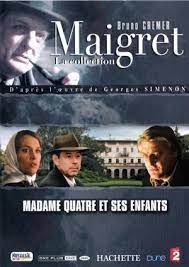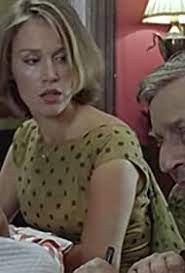IMDb meta-data is 1 hour and 31 minutes of runtime, rated 7.6 by 78 cinematizens.
Genre: Krimi, sub-species: Maigret.
Verdict: Different.

Set-up: Maigret is about to go on vacation with his colleague Inspector Vaimber and the latter’s brood, when an odd inquiry arrives. To handle it, Vaimber will have to put off his departure, disappointing his wife and numerous children. Knowing that Madame Maigret was not that keen on a fishing holiday, Maigret volunteers to look into the matter so that Vaimber can continue with his clan.
Thus, Maigret meets the enigmatic Madame Quatre, so called for the room number of her hideout in a boarding house. Her two tweenage boys are a brat pack of the first rank. She has fled the family home with them after seeing – she claims – the corpse of woman on the floor of the conservatory late one night while her very, very handsome husband was digging in the garden.
What follows is more Hitchcock than the usual Maigret. First and foremost is the ambiguity of Madame Quatre, played with screen-cracking intensity by Marianne Basler. Did she see what she said that she saw? Is she perhaps the villain, shifting the blame on to her husband, who now has himself vanished? Has he become her victim? Is she the villain? Slowly the mystery peels away.

To find out, stretching credulity, Maigret goes undercover taking a room at the boarding house. The atmosphere and inhabitants of the house conjure that the Henri-Georges Clouzet classic L’assassin habit au 21 (1942). Ensconced Maigret observes Madame Quatre unobtrusively (as if this bear of a man could be anything but obtrusive).
Maigret is outside his milieu and on his own to protect her and the children while ascertaining the truth of the matter. As he follows her narrative it seems ever more credible despite the lack of tangible evidence, but then he draws back, is he succumbing to a folie à deux? Has he become infected by her psychosis? She is so very convincing because she is so very convinced herself but is that enough? To gain some distance he brings another, younger officer into the house and this latter’s questions snap Maigret out of his trance. In this story he is even more passive than usual.
For three-quarters of the film, we just don’t know whom to believe and neither does he. Both the body count and the tension rises. Nor are we quite sure whether there will be another victim, or who it might be, until …. The villain emerges from the fish tank. Well, sort of.
The direction by Phillippe Berenger is excellent. Even the staircase contributes to the plot when the ankle bracelet is spotted. The screenplay is twisted but sustains interest, and the obvious turns out to be true all along. The number “4” is crucial in a way. If it had been done by Claude Chabrol the cinemaistas would be shouting it from the rooftops.
I cannot identify the title of the original Simenon work (short story or novel). Maigret Takes a Room is not it.
Dominique Roulet is credited with writing dialogue whose work from other films is excellent. I wonder if this was an original story? She did the adaptation of eight of the films in this Maigret series. The screen credit is ambiguous in the attribution about whether it is an adaptation or an original.
P.S.
I have watched several others upon which I may comment later. I have been watching one each evening when the Plex server performs as advertised. Have given up watching the TF2 news for a while as a relief from the daily dose of murder and mayhem, preferring to get my French lesson filtered through these films for a while. So as not to forget these others include:
Maigret et la vente à bougie (1995) – the cat deals with two mice when the candle goes out.
Maigret en Finlande (1996) – more images of watery Helsinki. Why the pipe smoker has a cigar at one point while staring definitely at Maigret is lost on this viewer.
Un Meutre de première classe (1999) – didn’t make use of train. The noisey consul disappears without explanation as above suspicion. The closed world of the railway carriage is dissipated in both screenplay and direction. Tant pis.
Maigret dans un jardin potager (1999) – intense but cryptic. Superb acting from the two warring sisters and for once a uniformed officer gets some dialogue.
Maigret chez les riches (2000) – credibility snapped. How murder saves the family name is lost of most viewers.
Maigret et la croquese de diaments (2001) with the great Michael Lonsdale as a red herring. Set in a canal lock near Belgian border but makes little use of it. Strangely enough the credits cite Lonsdale as Michaël with an umlaut that his name did not have. And, yes, he is ‘Michael’ and not ‘Michel.’ He appeared in an earlier episode which I watched out of order, and in the credits for that one, his name was correctly rendered.
Maigret et le marchand de vin (2002) – skips basic police procedure, does not question the maid, and accepts that no one recognises or thinks to mention the fired accountant. Contrast to others beating witnesses, his approach is softly, softly.
Maigret et la princess (2002) – Maigret at his best as detective and as a person. From the novel Maigret et les vieillards (1960), which title more accurately reflects the story. Slowly he comes to realise what motivates the occupants of the mansion. It was all so obvious that he did not notice it at first.
Maigret et la demoiselle de compagnie (2004) – from the short story La Vieille dame de Bayeux, in which a cardboard judge obstructs Maigret and then does a volte face to stay within running time. The sleazy villain is played perfectly.

